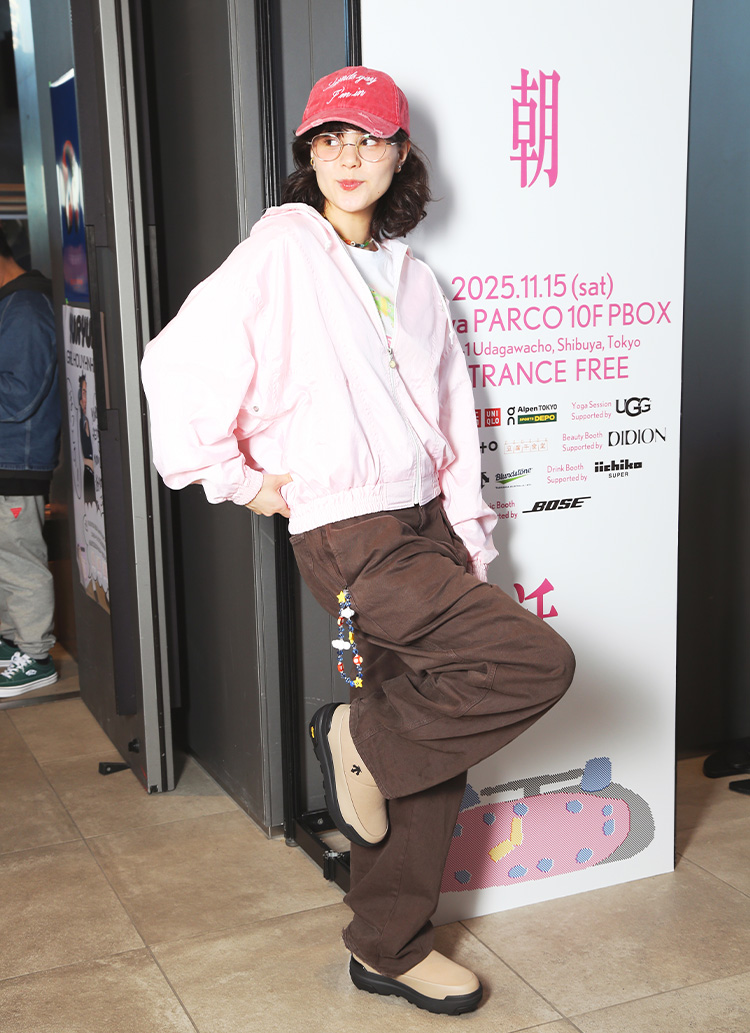



-
 Tomohiro Konno
Tomohiro Konno -
 Michihiko Kurihara
Michihiko Kurihara -
 Fujihara Yutaka
Fujihara Yutaka -
 Takashi Abe
Takashi Abe
PROFILE

Born in 1977 .
In 2001, he launched "NEXUS VII." in New York. He is also the creative director of the denim brand "Beyondex" and the professional basketball team "Altiri Chiba" in the B-League.
Instagram: @nexus7konno
PROFILE

Born in 1977, he started his career as a freelance buyer in 2011. He is one of the most trusted vintage buyers in Japan, not only from vintage clothing stores, but also from many select stores and brands. He also has his own store "Mr. Clean" in Oku-Shibuya.
Instagram: @michihikokurihara
PROFILE

Born in 1977 . In addition to serving as the director of the long-established vintage store "Berberzine" in Harajuku, he has used his extensive knowledge to plan denim for numerous brands. Levi's VINTAGE" is the culmination of the recent G-janes boom.
DENIM JACKETS Type l/Type ll/Typel lll", the culmination of the recent G-janes boom.
Instagram: @yuttan1977
PROFILE

Born in 1976 . He has been involved in men's fashion magazines as an editor and writer, and is an expert on many articles related to vintage clothing. He is also known as a collector of vintage bandanas. . He is currently in charge of content creation for e-commerce at BAYCREW'S.
Instagram: @abeabc1976
first lecture
Tomohiro Konno

70's TOWNCRAFT WOOL CHORE JACKET
Konno:The first is a pair of "Towncraft" coveralls. This is a wool version of Lee's classic 91-J model, circa 1970s. In addition to "Towncraft," "Lakeland" (a mid-sized sportswear brand based in Wisconsin) also seems to have released these. I missed out on a black version of the same model when it came out for the 20th anniversary of Berberzin, but the timing wasn't right.
Abe:You also have black.

Konno:Yes . I kept looking for a while after that, and I heard from people that it had appeared on Yahoo! Auctions and Mercari, but all of them were after-the-fact reports, and even at a friend's store, it had cost about 300,000, but it sold right away.
Abe:Wow, 300,000.
Kurihara:I have an image of Mr. Furuya (Mr. Furudate, vice president of Berberzine) often wearing this navy model, and I personally call it "Mr. Furuya's model" (laughs).
Fujiwara:Indeed . . even now, when I see a navy, I try to talk to Mr. Furu first.
Abe:If it's found in three different brands, was it OEM from somewhere else?

Fujiwara:I wonder . The items themselves don't appear anyway, so I haven't had a chance to compare them properly. The buttons on the cuffs of the "Town Craft" items are just decorations without any bridges, though.
Kurihara:It must have been around the same time that Lee was releasing multi-striped coveralls, so it must have been the right time for something like this to be featured in the context of fashion.
Abe:It's interesting that it's exactly 91-J, isn't it?
Kurihara:You're fighting with me pretty head-on (laughs).


Fujiwara:Well, we have created a way out, such as double-stitching the original triple-stitching.
Abe:Is it really that hard to get out?
Kurihara:I haven't seen it in the U.S. for about 15 years now.

Fujiwara:In the past, we have sold yellow, green, orange, and the navy mentioned earlier, but the brown one that Konno-san showed me was the first time I had seen it, and the black one was probably the first time for the 20th anniversary.
Konno:Just by using wool as a material, the image becomes a little more elegant, and it has a different charm from denim, but there are no such things, and even if I wanted to collect them, I could not.
Kurihara:Even though it is a fashion item, the silhouette is not a 70's silhouette like Peter Max of Wrangler, so it can be worn without any problem in today's sense of the word.
'It's embarrassing to be white on pins and needles, so I pulled out something a little dingy.'

50's Lee 100-J , 80's CARTERS CHORE JACKET
Konno:Next, let's look at white jackets. In the order in which I got them, there are Lee, Carhartt, and Carter's (founded in 1859 in New Hampshire, and still focusing on children's clothing). (Founded in 1859 in New Hampshire, the company still focuses on children's clothing.
Fujiwara:This is the first model of the Westerner (100-J), also commonly referred to as the "proto" model.


Konno:. yes, that's right. The tag is not white, but black like the denim of the time (101-J), there is no westerner notation, the pisname is ® only, and the buttons are of the type with the Rider's stamp on them.
Fujiwara:Since the official debut of the Westerner was in 1959, it was probably only produced in small quantities the previous year or at the beginning of the same year.
Konno:Of the several pieces I had on hand, I kept only this black tag and gave away the others, but I haven't seen them much lately and they weren't a bad size, so I pulled them out of storage.
Abe:Why the white jacket now?
Konno:I want to look as fresh as possible (laughs).
Kurihara:Here , please write "bomb" for all of us (laughs).

Konno:(Laughs). After my children were born, I thought that if I wore my clothes too raggedly, they might be bothered in some way (laugh), so I decided to go for something a little cleaner, but I was also embarrassed to wear something that was too white and tight, so I pulled out a slightly damaged, repaired, or stained item and wore it. I feel like I'm wearing something that is a little damaged, repaired, or dirty.
Kurihara:But how could you have bought such a large size so many years ago?
Konno:. maybe because it was a black tag. It sure looks like it's about 46 or so.
Fujiwara:(Spreading his fingers to match his waist belt) Yes, about 44 to 46.
Abe:What, you can tell now? You are indeed a professional. These prototypes have always been very expensive, and I don't think they have changed much.

Fujiwara:That said, during the vintage boom of the 90's, there were stores that were Not For Sale, and maybe they were more expensive then.
Kurihara:. When it comes to later models that are not proto, it is still around 50,000 yen. . I have an image that the market price has not changed much since the 00's.
Abe:That's right.
Fujiwara:The biggest change since then is the sizing. At that time, the larger the size, the cheaper it was, but now the trend has reversed, and the larger the size, the more expensive it is. The price range has gone up another notch when it comes to colorful items. The market price for a large olive is 200,000, 100,000 for a moka, and about 2 million for black.
Abe:There's red too, right?
Fujiwara:I've only seen two of them. I've only seen two of them so far.
Abe:I wonder if it is related to the Rodeo, like the red Wrangler (12MJZ)?
Fujiwara:. I can't say that there is no possibility that a very small number of them were made to compete at the time.

Abe:The "Carhartt" you wore today, Konno, is also a white jacket, right? Is this also something you got a long time ago?
Konno:This was about 5 years ago.
Abe:It's 40s with a heart tag , and it would still be quite expensive.
Fujiwara:Yes, that's right. A while ago, a green-colored one with green cankles came out, and when I put it on the market for 598,000 yen, it sold in an instant.
Abe:Does the cannequin come in red or green?
Konno:Most of them are red. . This was the first white jacket I started wearing when the white jacket craze started. Unlike denim, you can use a raw color like a tailored jacket, and it's easy to make it look like a tailored jacket.
Abe:It's really amazing how much Carhartt has skyrocketed in the past few years, isn't it?

Kurihara:Yes . I guess the trigger is the so-called regular type, like double-knee work pants and Detroit jackets. If those items soar in price, it is only natural that the ones before that will become more expensive, and overall, they are going up.
Fujiwara:That's right. The price started to rise gradually about 5 years ago, right around the time Mr. Konno acquired it, and it has gone up again in a flash in the past year or two. If it is raw silk, the price is about double or triple of what it was back then, and of course it depends on the condition, but if it is a denim heart button change and in near dead stock condition, it could fetch 5 million yen or so.
Abe:Five million (laughs).
Konno:In the late 80's and early 90's, there were several models of Stussy's NYC-only line that used Carhartt bodies, right? The price of that line soared. Even if it wasn't a special-order item, even the models that were used as the base for the line were soaring in price across the board.
Abe:I see. I knew the special order models were outrageous, but even the bodies have skyrocketed in price....

Konno:The third one, "Carter's," was probably from the 70s or 80s, but I liked the double-breasted style. I used to collect double-breasted coveralls from "Double Wear" (a mid-level store work brand), but they were all large, like overcoats, so I gave them away when I had accumulated a certain amount. I guess it would have been fine in today's sense. I also liked the "Still Made In USA" on the quality tag, so I have been sampling them for my own brand. I have sampled it for my own brand as well.


Abe:That's cool.
Kurihara:The register number on the quality tag indicates that it was made by "Smart Style Industries," so production may have been outsourced (Oshkosh and others are now under the Carter's umbrella). The buttons also have "SELEX" stamped on them, which is not often seen.
Konno:If it's a Selex, it's not that old, maybe in the 80's. . It doesn't look so good when worn open in the front, but when fastened tightly, it can be worn a little stiffly like a P coat, so it is quite useful.
. probably the thrift stores look at me like I'm the apple of their eye. Sometimes when I'm standing in line at the Rose Bowl early in the morning, I get those looks."

40-50's KAHANAMOKU ALOHA SHIRT , 50-60's OPEN COLLAR SHIRT
Konno:Next, I brought several short-sleeved open-collared shirts, including Hawaiian shirts. The first is a shirt I got for the 25th anniversary of Berber Gin, commonly known as the "Monroe Pattern" shirt. . The buttons are large, and I'm thinking it was probably pajamas.
Kurihara:It's possible that there's a pair of shorts and that they're beachwear. Short-sleeved pajamas don't have a lot of balls.
Konno:Sure, there could be a line.
Abe:When was it from?

Fujiwara:(Marilyn) Monroe was in her heyday, so I think it must have been around the 60s, even if we go from 50.
Konno:After I got this, I actually saw a long-sleeved shirt with the same pattern, but without knowing the details. However, I have already sampled this pattern for my own brand, so I thought it would be okay to release it to the world (laughs).
Abe:Were the long-sleeved ones pajamas?
Konno:No, I didn't see the thing itself in person, but rather in a "Berberzine" pre-shipment video, so I couldn't see all the details.
Abe:I see.

Konno:The second one is a pineapple pattern from "Kahanamoku. Of all the pineapple patterns, I like this one by Kahanamoku because it is exceptional, and the fact that it is black and white was also a deciding factor.
Abe:Usually it's green or navy.
Konno:. yes, I did have a black and pink one, but it wasn't in good condition so I let it go. I also had a black and pink one , but it wasn't in good condition so I had to let it go.
Fujiwara:I used to have an oddball black and purple one myself .
Konno:Is that even possible? Dark purple?
Fujiwara:It was not extremely dark, but the color was clearly different from pink.
Abe:Black and pink is extremely rare, but black and white is pretty rare, right?
Fujiwara:Yes, that's right. I saw it for the first time.
Konno:As I recall, it was given to me at Inspiration (a large vintage exhibition held periodically in LA), and although I didn't pay much attention to it at the time, when I started looking for it after I got it, I couldn't find it at all.
Abe:Age: about 50?

Fujiwara:It's the 40's to 50's because of the big tag (the inner tag transitioned to smaller in the 60's).
Abe:I don't wear rayon much, so I don't know.
Konno:. I'm afraid I'll have to send it to the cleaners, too. However, this one is labeled "washable".
Although recent technological advances have led to the development of rayon that does not shrink, older rayon such as vintage rayon has a characteristic called "swelling and shrinkage," in which the yarn diameter becomes thicker and the length shrinks when it absorbs water.
Abe:Well, even though it says so, it is indeed not easily washed (laughs).
Konno:Yes.

Kurihara:But it's frustrating when a non-buyer like Konno-san pulls out the good stuff quickly when Japanese buyers are working so hard to get it, like Inspiration and Rose Bowl (laughs).
Konno:I probably get a lot of eye contact from thrift stores (laughs). Sometimes when I'm standing in line at the Rose Bowl early in the morning, I feel that kind of stare (laughs).
Kurihara:I told him not to come play with me (laughs).
Konno:Yes, yes. But I have to work, too (laughs).
Abe:In Konno's case, can't he be put in as a vendor with Yamada-san (Berberzin's representative) and others?
Konno:Yes, I am. Mr. Yamada's presence is really important. Dealers over there come to me as soon as they find you.
Abe:Wow . You must be an amazing person after all.
Fujiwara:I happened to see a buyer who hadn't opened a store in 20 years, and he was selling at the same prices as before. I was a bit busy, so I didn't get a chance to take a good look at the items, but when I reported back to Mr. Yamada later, he told me that he had already removed most of the items of interest in the morning (laughs).
Abe:That's as good as it gets.
Second lecture
Michihiko Kurihara

80's-90's ERO T-SHIRT
Kurihara:The first is T-shirts with erotic motifs. At first glance, it is hard to tell, but I have brought several items that can be worn as a joke. I am a seller of secondhand clothes, so I may have a problem saying this, but honestly speaking, I have been having a hard time with the rising prices of T-shirts in the past few years.... . I dare to say that there are definitely some interesting things among them that have not yet skyrocketed in price.
Konno:You can't even buy them in the U.S. anymore at prices you can't afford.
Kurihara:Yes, it has. But as for the U.S., I feel that things have calmed down a bit compared to the peak. After all, young buyers over there are gradually shifting from T-shirts to true vintage. . It seems that in Thailand and Southeast Asia, the market price is still going up.
Abe:What categories are rising?

Kurihara:I'm mainly interested in bands, movies, art, mainly photo prints, and Stussy.
Fujiwara:You think it's one of Stussy's most expensive?
Konno:I think some of the models are quite rare, including T-shirts that were given out to the crew at the time and other items that never made it to the market, so it's an unknown quantity.
Kurihara:Rare models in that area, as well as models of intermediate standing that have not seen the light of day so far, have skyrocketed in price.... Since a few years ago, US-made black tags have often cost around $100 in the US, regardless of the design.
Abe:Is Powell's getting more expensive?
Konno:. it's expensive.

Kurihara:In recent years, I think that the cause of the sudden rise in the market prices of various items is often found not in secondhand clothing stores such as ours, but in private sale sites such as Yahoo Auctions and Mercari. When someone wins a bid at an abnormally high price that ignores the past market price, other people who see the bidding tend to follow suit, thinking that the exorbitant price is the market price.
Konno:I was told once by some T-shirt collectors that if they look on Yahoo! Auctions or Mercari and see three or more of the same model at a reasonable price, they consider that to be the market price and thereafter they will charge more than that.
Kurihara:I see , that's how it works.
Abe:By the way, when did you start collecting erotic motif T's?


Kurihara:. about 10 years ago. Past.This projectIn the "Where the Wild Things Are" section, I introduce William Wegman's photo prints, Raymond Pettibon, and Maurice Sendak's "Where the Wild Things Are" T-shirts, but once those became popular, I found it hard to wear them. Gradually, I felt that I drifted toward erotic motifs and other categories that had not yet attracted much attention.
Abe:Is it quite common?
Kurihara:Souvenirs of so-called brothels and the like are quite common, but this kind of thing with a bit of a joke is surprisingly rare.
Fujiwara:By the way, what is that T-shirt you are wearing today?
Kurihara:I don't know him at all (laughs).
Abe:Eh (laughs).

Kurihara:Originally, I liked "Chappie" in Osaka, "Mecha" in Koenji, and others in the Kansai area. They call it the "Who the hell is this series" (laughs), but I wear it out of respect for them. I made a small number of these items for families to wear themselves on birthdays, Christmas, and other anniversaries, but most of them are photos of children and old people, and I find it somewhat difficult to wear old people's items, so I buy children's items whenever I find them.
Abe:That's interesting (laughs).
I personally don't see Carls Junior, which is what I'm looking for the most.

80's-90's McDonald's T-SHIRT
Kurihara:Next is a McDonald's T-shirt. Although he is called Donald in Japan, his official name overseas is Ronald the Clown, and there were quite a few original characters a long time ago.
Konno:Looks like they're getting more and more complaints, and they're getting less and less used.
Although there are various theories, such as fear exclusion and diversity, the most popular theory is that the "anti-Ronaldo movement" (which was started by CAI, or Corporate Accountability International, an American citizen's group, around the early 2000s) was influenced by this movement. The most popular theory is that the "Anti-Ronaldo Movement" (which led children to high-calorie, unhealthy foods by adopting pop characters) started by CAI (Corporate Accountability International) around the early 2000s has influenced the movement.

Kurihara:I think the younger generation today just barely knows Donald, and probably doesn't know the other characters.
Konno:. there were all kinds of people. . like the Big Mac Police and the Hamburglar.
Kurihara:There was also a hairy bird (birdie). However, although McDonald's is a national dish in the U.S., there are surprisingly few T-shirts or apparel items.
Abe:Heh . That's certainly surprising.
Kurihara:When they do appear, they are mostly novelty T-shirts and uniforms of recent years.
Abe:Is what you brought today reasonably old?

Kurihara:. the 80s and 90s. Souvenirs sold at the world's oldest McDonald's in Downey, novelties from McDonald's France, and so on.
Abe:Are there not that many McDonald's type collectors?
Kurihara:If it is limited to T-shirts and other apparel, I think there are quite a few collectors of IT-related corporate items such as Apple and Microsoft, but I have not heard much about McDonald's. .


Fujiwara:This is a genre that seems to be popular and trendy among the current generation.
Kurihara:But with the older ones, most of what comes out is for kids, and sizes for adults are seldom available.
Fujiwara:I see.
Kurihara:As for other fast food chains, In and Out Burger still sells souvenirs at each of their locations, so you can find quite a few, but you don't see Jack in the Box or KFC very often, and Carls Junior, my personal favorite hamburger chain, is rarely seen. Only Taco Bell has a huge number of balls, though.
Fujiwara:I'll keep an eye out for it.
I have a few official ones, but I personally like the ones that are a little different."

70's-80's BOOTLEG T-SHIRT
Kurihara:Next is a boot T of the mascot character of a certain dreamland. I like the official classic Mickey and the Fantasia type, and I have several of them, but I personally like something a little different.
Konno:This is bad (laughs). (Laughs.) I'm sure he's the kind of guy who would get angry.

Kurihara:If I wore it to Dreamland, I might be kicked out (laughs). The light blue one is based on the Hanford Site in Washington State, a group of nuclear facilities that existed from the time of the Manhattan Project, and the rats are wearing protective masks because it is the most radioactive place in the United States.
Abe:When was it from?

Kurihara:. 80's. This type with clogs is another shot older, from the 70s, and I found it in Hawaii the other day, and the design is very Hawaiian, with a lot of Japanese Americans.
Fujiwara:This California one also has an interesting balance of prints.
Kurihara:Yes, yes. This one is from the 70's or 80's, but I like the use of slightly older motifs and the mysterious balance of the print position being so far up.

Konno:You know the famous official pose called "standing pose"? It seems that in recent years, that pose has been regulated, and it is no longer easy to use.
Abe:Heh . Why is that?
Konno:Did everyone use it too much all at once? By the way, it seems that the ones you sometimes see with the name of a specific area or school, such as California or Herbert, are also not allowed nowadays. It seems that the character belongs to everyone and should not be associated with a specific area or group.

Abe:I see. . I saw on the news that the copyright of the very first black-and-white painting is about to expire.
Konno:It seems that in the U.S. they were prolonging the life of that character's birthday while complicating the copyright, but it looks like that prolongation is finally no longer working.
Kurihara:It is also historically interesting, as it was designed as a scordron (unit insignia) used by the U.S. military during World War II, and there was even a film produced as wartime propaganda.
Third lecture
Fujihara Yutaka

70's-90's PEANUTS OFFICIAL T-SHIRT
Fujiwara:I chose the official peanut brand. The official Peanuts products from the 60's and 70's are probably the most famous ones, and in fact, their prices have skyrocketed in recent years, but there are also some interesting ones from later years.
Konno:I still wonder if it was NIGO® that triggered it.

Kurihara:. I'm sure you're right. The "spruce-body" Peanuts were also exhibited in a large scale at the solo exhibition "THE FUTURE IS IN THE PAST" held in 2022 at the Bunka Fashion College Museum (Bunka Gakuen Reinstatement Museum). I believe that these items triggered a worldwide resurgence of popularity and a surge in the market price. However, they were sweatshirts.
Konno:They're already priced so high that even in the U.S. they're totally unaffordable.
Fujiwara:Yes, I know. I found one sweatshirt in LA the other day for the first time in a long time , because it was normally $1,000.
Konno:If you know the old prices, as we do, it's even more difficult to afford.

Abe:Sweatshirts are rare, but you don't see more T-shirts.
Fujiwara:Yes, I agree. The front and back print itself is similar to the sweatshirt, but we think that, as it stands, the T-shirt was probably less varied, although it is hard to say, since it is something that does not appear at all.
Abe:Except for the "Spruce," are all the others recent?

Fujiwara:It's not that old . Charlie Brown, who is wearing this denim, got it about five years ago, and I thought the "be an idiot" message was interesting. I think most of the official ones are made with this " Changes " body.

Fujiwara:The other two pieces have the character's initials in the "Calvin Klein" style, and the character's picture is printed on the back. I have been trying to collect them, but they have started to soar in price recently....
Abe:There's always been one type of character that's unusually expensive, right?

Fujiwara:. You can see one of the pig pens that I brought today. The "spruce" body ones are by far the fewest in the swatches, and they have always been the most expensive. However, the "Changes" pen that I brought today is currently available for around 10,000 yen, so I think you can still enjoy it.
I thought it would still be affordable and enjoyable around here."

50's-60's COTTON HAWAIIAN SHIRT
Fujiwara:. Next, I brought some cotton Hawaiian garments. I feel that the market for so-called vintage Hawaiians like the Kahanamoku that Mr. Konno showed us earlier has risen dramatically this year compared to last year and the year before, so I thought that, like the peanuts I mentioned earlier, they might still be affordable and enjoyable in this area.
Konno:Are vintage Hawaiians skyrocketing in price again?
Fujiwara:. The price has been going up for the past year or so. A few years ago, if you paid 400,000 yen, you could buy a special item like a battleship or a fighter plane in that category, but since last year, it has become commonplace to pay 300,000 yen for a standard item like a tiger head. In the same vein, vintage Hawaiian items with Japanese patterns began to soar.
Kurihara:Well, it's easy to see and understand, so it will probably be popular overseas. . Indeed, I have an image that the popularity and market price have been slowly increasing over the past few years.


Fujiwara:. and in the midst of all this, we have cotton Hawaiians. Two of them have a black base, and the other has a Jamaican pattern, so you can't officially call them Hawaiian.
Abe:I'm guessing 50 to 60 years old?

Fujiwara:Yes . This one in the style of a Matson menu (the menus used in the restaurants of the Matson Line, the luxury liner that once connected the U.S. mainland with Hawaii) is probably from the 50s, and the other two from the 60s.

Kurihara:Strictly speaking, this black is not Hawaiian, since it's also a Bahamian motif.
Abe:Was it Souvenir?
Kurihara:I think that's probably true. For example, if there were a rayon and a cotton with the exact same pattern and age, the rayon would be twice as expensive as the cotton.
Fujiwara:Maybe not twice as much.
Abe:Why wasn't cotton so popular?
Konno:I believe this is because the original intention was to use silk, but it was too expensive to use, so rayon was adopted as an alternative.
Abe:. If we consider only the Japanese used market, cotton seems to be easier to handle and more suitable for the climate.
Kurihara:. But I think the luster that only rayon can give is what makes it so appealing. It's a little bit sexy.
Konno:. I guess the fall of the fabric and the toro are also attractive.

Fujiwara:At Fake Alpha, one of our affiliated stores, Mr. Sawada (manager) is very particular and has been rolling out Hawaiian shirts earlier than anywhere else, and this year we put them out again in February, but the staff at the pancake shop on Propeller Street saw us wearing Hawaiian shirts earlier than that and lamented that we had beaten them to it (laughs). .)
Kurihara:That's just a uniform (laughs).
Konno:We'll just have to keep them in the store all year round now (laughs).
Abe:I wonder if the soaring popularity of Hawaiians is still influenced by the popularity of short-sleeved open-collared shirts?
Fujiwara:I'm sure there will be some. I was wondering if I should bring it today, but the price of "Pataloha" (Patagonia's Hawaiian shirt line) is gradually going up, so it might be a good idea to get your saliva on it while it's still available.
We finally wash them when they won't grow any more."

NORI-ZUKE DENIM
Fujiwara:Just the other day, I received a request from Takuya Kimura on his YouTube channel to wash and glue his jeans. Since then, Berberzine has been inundated with requests for gluing, so I would like to talk a little about washing and gluing, referring to 501®︎ and 505®︎, which I glued before.
Abe:Can you glue it up for me at "Berberzine?"
Fujiwara:Yes, I did. I have trained my staff so well that they are now all able to glue the garments on. There have been many cases where customers have purchased the reissued model as a top and bottom set-up at the Levi's ®︎ flagship store in Harajuku and brought them straight to our store. We charge 3,800 yen per pair of jeans.

Kurihara:Is that profitable? I could understand if it was purchased at "Berberzine" (LOL) .
Fujiwara:Well, well, well (laughs).
Abe:Some people want Yutaka to do it himself, right?
Fujiwara:Yes, that's right. The other day, a customer who purchased an XX worth about 800,000 yen wanted to have it glued as is, and the paper patches were a little hardened. However, we are still very careful with vintage items, so we are thinking of reducing the price to 3,800 yen for current items and 10,000 yen for vintage items.
Konno:Is the one you're wearing today also after gluing?


Fujiwara:Yes . I glued one of my personal items after Mr. Kimura's video recording, and it has been just about 2 months since I glued it. 505®︎ but the shaft is narrower than 501®︎, so it is easier to get the beechnut. The 505 that I brought as a sample was also about 3 years old after being glued. For easy comparison, I also brought a 501 Big E that has not been glued yet.
Abe:You used to glue the dead 66's on and wear them all the time.
Fujiwara:Yes . I wore that one almost every day for 1 year and 7 months, but I wanted to grow this 3-year player slowly, so I did not wear it in the summer and slowed down the pace to about 3 times a week.
Konno:. In the summer, the glue would melt out and my legs would be sticky.
Fujiwara:It's a little sticky, but it's totally acceptable (laughs).

Abe:The beechnots seen in so-called "mine denim" are so clearly visible because the denim was bought and worn as is, right?
Fujiwara:I think I took just the flashers off when I bought them and wore them for a few years as they were, even more true to size. Then, after a few years, I washed them and they shrank so much I couldn't wear them anymore , so I think I gave them away.
Abe:I see.
Fujiwara:So only the parts that are hard to rub, such as the inside of the waist belt, remain in dark blue.

Abe:So, once the glue is applied, you don't wash it until the color of the beehives and bites are satisfactory, right?
Fujiwara:Yes, I finally washed the ones I had worn almost every day for 1 year and 7 months, when I was sure they would not grow any more. The water turned brown because all the dirt that had accumulated during that time was washed off at once.
Kurihara:After one wash like that, do you re-glue it again?
Fujiwara:No, I mean that it is a finished product, and from that point on, I would wear it normally anymore.
Abe:You have to take care of the laundry.

Fujiwara:For laundering, I use Beyondex detergent, which was developed mainly by Mr. Konno. This may sound like flattery, but this detergent really removes only the stains without removing the original denim dye.
Abe:. you should always wash it before gluing it, right?
Fujiwara:Yes . I glue it from the one-wash condition, but as for laundry glue, I buy it in bulk online since it is hard to find in pharmacies and other places these days. If you glue the surface, it will be very shiny and sticky, so basically, you should only glue the back side of the garment. As for jackets, I think gluing only the back side of the arms is the right way to go.
Abe:I see. . it doesn't make much sense to glue the jacket all over, does it?
Fujiwara:Yes . Why do you recommend gluing on the back side for pants and only on the back side of the arms for jackets.
Fourth lecture
Takashi Abe

40's CHAMPION SWEAT
Abe:The first is a double V sweatshirt from Champion , circa 40's as you can tell from the tag. I like the print. Recently, the price of so-called "post-attached hoodies" (parkas with the hood attached after the hood) has been rising a little too high, so I chose this one. The size 44 is also one of my favorites.

Kurihara:. but even crew necks are expensive enough.
Abe:Really?
Fujiwara:No, it's going up so much. Well, it's certainly still more gradual than the retrofit.
Abe:The current market price for a retrofit is something like $1,000,000.
Fujiwara:. 2 or 3 million depending on the condition and the color scheme and pattern of the paneling.
Abe:It's a little crazy....

Fujiwara:This is not a post-printing (a fake print applied later to increase value), is it? (LOL)
Abe:No . (laughs).
Kurihara:(Laughs). Older prints like this one have poorer printing techniques, and this one has a slightly distorted outline, making it look like a post-printing (laughs).
Konno:. but the way the black color comes out makes it look original (laughs).
Abe:. but if the post-preparation gets lost in the market, you'll never really know. But I guess we'll never really know if the post-prep will get lost in the market.

Kurihara:I heard a rumor from someone that in the 1990s, a large number of the plain Spruce sweatshirts that Yutaka mentioned earlier were found in the U.S., and that a local vendor had printed the Peanuts series on a large number of them. If this is true, it would be hard to recognize them if they were to appear now.
Abe:That's really scary. I know there are some fake afterthoughts out there.
Konno:It seems that fake products are already appearing on Mercari, and someone is selling a retrofitted parka released a long time ago from a Japanese reissue brand with only the tag transplanted from the real thing, and my friend seems to be patrolling for such crooks (laughs).
Abe:It's vicious....

Konno:It is not an afterthought, but parkas called "rock hoods" are sewn with thick rayon threads of a rather special pitch count. So there are not many factories that accept them nowadays, and even if you want to reproduce them, it is not so easy to do so.
Abe:I see. If you think of it as so-called "roles," the highest level is posterior, followed by both V's, then proprietary standards such as separate pockets and freedom sleeves, and finally front V's?

Fujiwara:Yes, it is. And then there's the color. Spalding's unique boxing-glove-shaped pockets are exceptionally expensive.
Abe:Come to think of it, I haven't seen any boxing pockets lately.
Fujiwara:It doesn't come up at all.
Abe:I wonder if people who collect reverse weave are not really interested in this one (plain sweatshirts from the 100% cotton era released before the 60's)?
Konno:I wonder . I can't say, as I'm sure many people are choosing based on size, but at least if they were going for a beat-up tag or an older unit among the reverse weave, they could be drifting this way.
The market has calmed down a bit, and now it's fresh again."

60's-70's CHAMPION FOOTBALL T-SHIRT
Abe:Next up was "Champion" again, but I brought some football T's and T-shirts.
Kurihara:I wonder when this type of size notation changed from numerical to alphabetical.
Fujiwara:I think they are used in parallel, but I wonder what the segregation is indeed.
Kurihara:The inch markings have longer lengths and more elaborate specifications, and I have a feeling that those are the ones that were actually used in competitions.
Fujiwara:Oh, I see. I'll try to pay some attention and take a look at it.

Abe:None of them are that old, about 60s to 70s, but I simply liked the way they looked and acquired them.
Kurihara:Personally, I think that if it were Champion, the one with the University of Washington rose pattern and rose bowl motif would be "Takashi Abe's model" (laughs).
Abe:I wore it in a snapshot in "Boon" magazine a quarter of a century ago (laughs). (Laughs.) I used to wear it a lot, but I don't have it anymore. . But I'll definitely buy it if it comes out again.
Konno:That rose is nice, isn't it? I like it too, and I sampled it for my own brand before (laugh).


Abe:Overall, Champion's T-shirts have become more relaxed, haven't they?
Kurihara:It had calmed down a lot for a while, but I think it has recently been gaining popularity again, and the prices are getting higher.
Abe:If it's a football T and a plain T, the football is still more expensive, but I think it's a little easier to buy than it was at its peak.
Fujiwara:Yes, that's right. Of course there are individual differences in color and print, but it is becoming less and less like the old days when you could only get a high price if you were a "Champion.
Abe:However, most of what I brought today are things I bought a long time ago, including things I got when I was a student. The market has calmed down a bit, and I've been wearing only plain clothes for a long time, so I thought it would be refreshing to see them again. I'm a bit of an innocent at heart (laughs).
Personally, I don't position polymix as a vintage."

30-40's VINTAGE BANDANA
Abe:. Let me close with a bandana again. I brought two types this time. The first one is a bandana from " Double R.L. " and the other is the original. The original one is binaural and probably dates back to before the 1930s.


Kurihara:Are the ones from "Double RL" also old?
Abe:I think it was in the 2000s. I gave it to my wife because it was not in my collection, but upon closer inspection, I realized that I had the original (laughs).
Konno:I knew you had a solid original story.
Abe:Of course, if you look closely, you can see that the size of the pattern and other details are different. Of course, if you look closely, the size of the pattern and other details are different, but I feel a kind of respect for the vintage.

Fujiwara:The one with the surf pattern over here is an old one too, right?
Abe:I think it was in the 30's to 40's as well .
Fujiwara:It became hard to touch at once (laughs).
Abe:The surfing and palm tree pattern is one of my top five favorite bandanas. I've had the red one for a long time, but I found the navy blue one at an online auction the other day and bought it immediately. I think it might be a souvenir, since they rarely come up.
Fujiwara:I would like to know why it is in the top 5.
Abe:It is rare to find a bandana with a surf pattern, and the design and balance of the print is most wonderful.
Kurihara:. Certainly there are no surf patterns in the 60s and 70s or even in the younger generation.

Fujiwara:Do you have any reason to believe it was in the 30's to 40's?
Abe:. first of all, it's double-edged. Of course, it is impossible to say that there is no such thing, but I think that by the 1950s, looms that weaved in this width were disappearing. It was a time when mass production was shifted to a wider range of weaving.
Kurihara:The trunk up (the elephant, the symbol of the Elephant brand, which was a major brand at the time, is called a trunk up and appeared after the 60's. Before that, it was called a trunk down or a lower nose and hung down. Prior to that, it was called trunk down or lower nose, and the nose hung down.
Abe:There should be two ears on the trunk down, but only one ear on the trunk up.
Konno:Abe, do you have a definition of a vintage bandana? If so, how old is it?
Abe:Recently, poly blends from the 1980s onward are also considered vintage bandanas. In fact, they are so popular that their prices have skyrocketed. However, in my opinion, only cotton 100% is a vintage bandana. I don't find the print and the feel of the poly-blend so appealing.... . the best way is to collect what you like regardless of the age. . anyway, vintage bandanas are a swamp (lol).


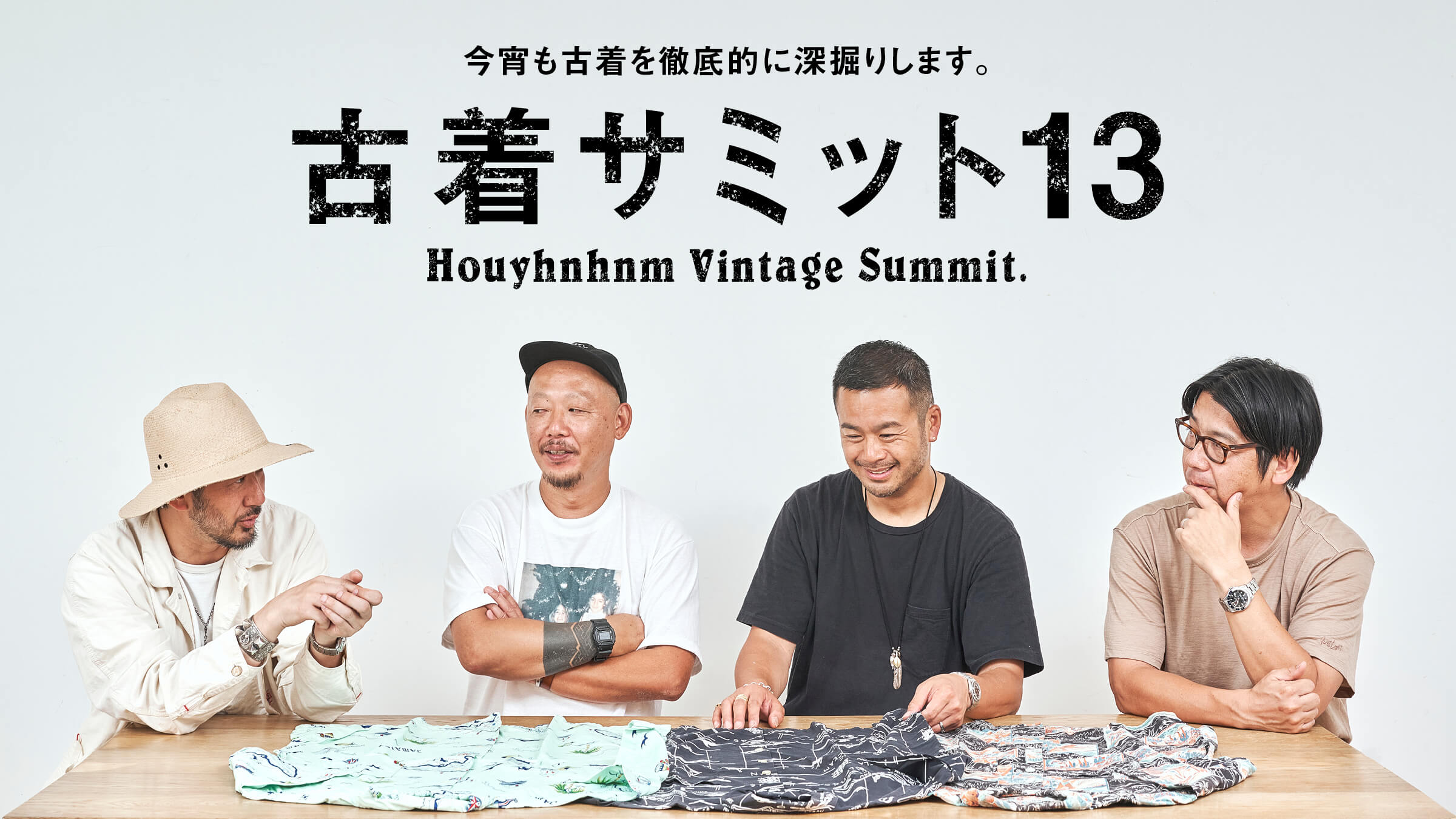

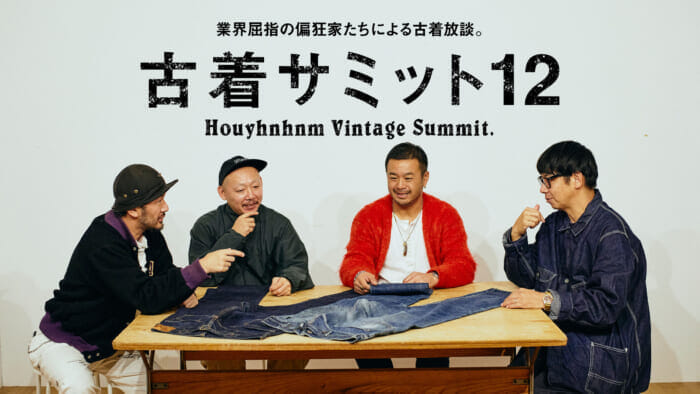
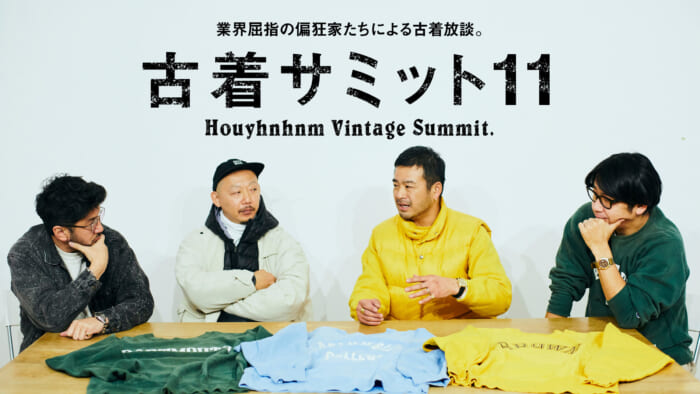
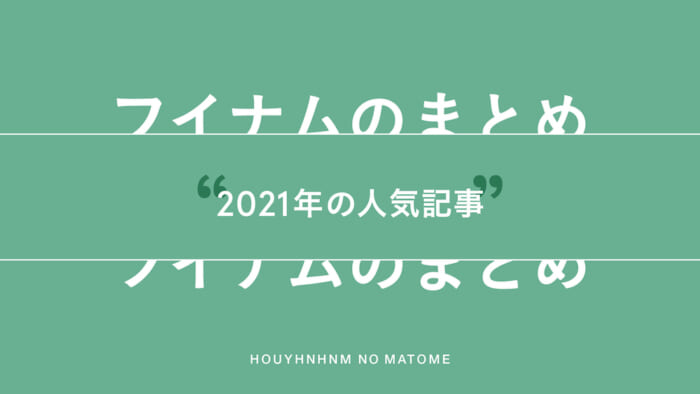
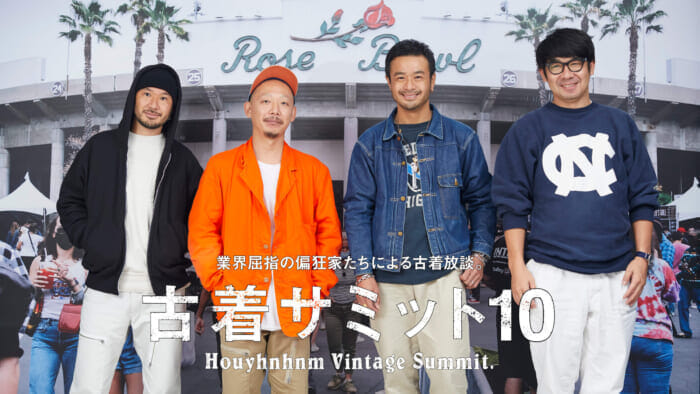
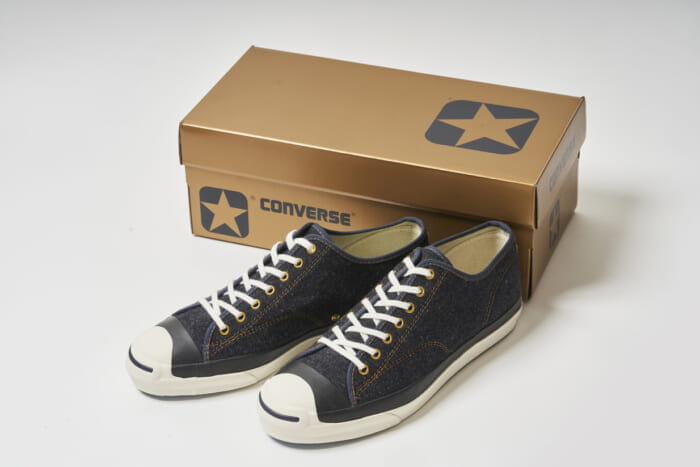
![HOUYHNHNM's YouTube] HOUYHNHNM's pre-orders sold out immediately! What's so great about Vintage Summit's special order Converse!](https://www.houyhnhnm.jp/wp-content/uploads/2021/04/HY_panel-700x394.jpg)





